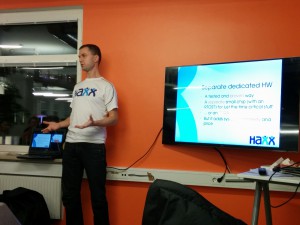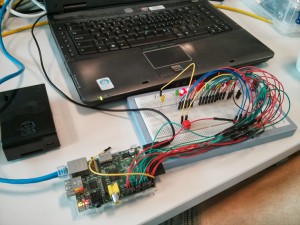Just in case you missed my YouTube posting from yesterday about my new trip to work:
All posts by Daniel Stenberg
This is my first day at Mozilla
I’m now a Senior Network Engineer at Mozilla. Today is my first day as an employee. Here’s my summary of how I got here and how the process has been so far, from my perspective.
Mozilla is an American company
OK, that’s not news to anyone and neither is it to me. I’m starting off with this because I’m not American. I’m a Swede, and I live in Sweden. When working and communicating with my fellow people at the mothership I of course get the slight cultural differences that are American versus Swedish. It’s not a problem because I’ve gotten quite used to working with Americans at work over the years but going through an entire recruiting and starting-a-new-job process entirely in English with Americans is new to me.
Interviewing
So when I was opening up to my social network to start looking for new assignments since I decided to end my previous one, I was approached by a friend who works for Mozilla. Of course I was interested to work for Mozilla!
So I had a Skype interview with a recruiter first, and then with two engineers. During evenings of course since Mozilla like many other tech companies are mainly in the west coast of the US, meaning -9 hours from me.
After those initial interviews I had to struggle with myself since I was in this luxury position of having no less than two other very interesting projects being suggested. How do you pick the best one out of three really good alternatives? I actually had to wrestle with all the details and factors involved and I decided that this lead was the best out of the three. If Mozilla wanted me, I’d go for that option.
So I took 4 days off from my current work and flew out to Mountain View California one day in November 2013. It takes some 17 hours to get there, I had a spare day to get somewhat adjusted to the time zone and then I fired off no less than five 45 minute interviews in a row that Wednesday. Then I got a ride back to SFO and I took the plane back home.
I’ve been a consultant for 16 years and I’ve done way over 30 projects during this time. I’ve been interviewed for all of them, and a bunch more that I didn’t end up getting. You can say I’m quite experienced in getting interviewed for work. What I’ve learned is to stay honest, just be me and have an as good time as possible but in the end it really isn’t possible to tell how the other end interprets me and my answers and if I match what they desire.
Getting hired
They didn’t reject me. I got the offer. I said yes. I signed the papers.
So one of the most frequent questions I’ve got when I told friends about my new job:
So you’re not gonna be a consultant anymore?
And no, I’m not. This option only came in the form of an employment or not at all, and I decided I wanted to do this rather than the alternatives. I’ve done consultant based development since 1996 and now I’m not anymore! Of course I still have tight bounds to Haxx and I certainly won’t exclude that I’ll return there one day.
My agreement also allows me to spend some time on curl development. Don’t you worry about that. I feel confident that I will only increase my commitment and efforts there.
Getting anxious
Once I had accepted the job I immediately wanted to start and by golly I got a harder time trying to motivate myself do good the period until that assignment ended.
I’ve had more phone meetings, I’ve checked out code and repeatedly rebuilt Firefox since then, I’ve read Bugzilla entries and perhaps most of all I’ve participated in Mozilla’s “onboarding program” which is a web based system that gives me tasks and asks questions and provides information, all in an effort to give them the information about me that they need and give me the proper info on Mozilla, what it is about, its background and what we’re doing ahead. (See how smoothly I used “we” there?)
Anxiously waiting for The Day. This may sound a bit melodramatic to some, but I do kind of feel like my life is changing a bit now into something it wasn’t before.
Starting a new job working remotely at day one
Today is The Day. I assume not everyone of you reading this have done it, but I start my first day at my new work for my new employer on the upper floor of my house, completely alone. I work from home, remotely and I’m also mostly isolated from a large portion of my colleagues by time zones.
So I grab my coffee and walk up the stairs to my home office. I sit down and I dive in. Source code. Lots of source code.
There’s a steep learning curve here, but I’m not afraid of some hard work and I like a challenge, I like code, I like open source and I like internet protocols. And I have good coffee.
Mozilla. I’m here. I’ve started. Today.
I go Mozilla
In January 2014, I start working for Mozilla
I’ve worked in open source projects for some 20 years and I’ve maintained curl and libcurl for over 15 years. I’m an internet protocol geek at heart and Mozilla seems like a perfect place for me to continue to explore this interest of mine and combine it with real open source in its purest form.
I plan to use my experiences from all my years of protocol fiddling and making stuff work on different platforms against random server implementations into the networking team at Mozilla and work on improving Firefox and more.
I’m putting my current embedded Linux focus to the side and I plunge into a worldwide known company with worldwide known brands to do open source within the internet protocols I enjoy so much. I’ll be working out of my home, just outside Stockholm Sweden. Mozilla has no office in my country and I have no immediate plans of moving anywhere (with a family, kids and all established here).
I intend to bring my mindset on protocols and how to do things well into the Mozilla networking stack and world and I hope and expect that I will get inspiration and input from Mozilla and take that back and further improve curl over time. My agreement with Mozilla also gives me a perfect opportunity to increase my commitment to curl and curl development. I want to maintain and possibly increase my involvement in IETF and the httpbis work with http2 and related stuff. With one foot in Firefox and one in curl going forward, I think I may have a somewhat unique position and attitude toward especially HTTP.
I’ve not yet met another Swedish Mozillian but I know I’m not the only one located in Sweden. I guess I now have a reason to look them up and say hello when suitable.
Björn and Linus will continue to drive and run Haxx with me taking a step back into the shadows (Haxx-wise). I’ll still be part of the collective Haxx just as I was for many years before I started working full-time for Haxx in 2009. My email address, my sites etc will remain on haxx.se.
I’m looking forward to 2014!
Parallel Spaghetti – decoded
Here’s the decoding procedure for the Parallel Spaghetti Decode challenge.
Step 1, the answers to all the questions. You will notice that I did have some fun in D6 and E2, but since they were boxes that weren’t on the right track anyway I thought you’d still enjoy them.
Step 2, let me illustrate how the above answers will take you through the maze. The correct path is made up out of yellow boxes and the correct answers are shown with red arrows leading forward. Click it for full resolution version.
Step 3, those different colors in the “Word” column give you the words used for the two questions. If you rearrange them, the two questions become:
which tr command line option specifies delete characters
and
what curl command line option specifies POST requests
So, it took about 14 minutes at our event for Oscar Andersson to bring the correct answer to me:
-d
Always have everything proven to work
… the slides from my talk today at Techdays by Init in Stockholm:
Parallel Spaghetti Decode Challenge
At the embedded hacking event in GBG yesterday I organized a small contest for the attendees. I’ve done something similar several times before, so I wanted to make it a bit different this time to spice things up a bit. A straight-forward N questions in a row and then a puzzle to get the final question was too easy. I wanted to create a maze or a play-field that you would need to traverse somehow in order to reach the final goal. But it is hard to create a maze that you don’t immediately spot the way through or that you can somehow “cheat” and find the way in other means rather than to actually answer the questions and do right by using your skills… Then I realized that with just a couple of things added, I could fulfill my goals and still get a fun contest. So, let me start by taking you through the first slide that details the rules:
Ok, so to make the rules be a bit clearer we take a look at a simplified example play field so that we understand what we’re about to play on:
A short summary:
- start on a green box
- follow the arrow in the direction that your answer to the question of the box leads you. There’s a compass rose there to help you remember the directions! 🙂
- each box you visit has a word associated with it, collect the words along the path
- when you reach the red box you’ve read the goal and you’re done
- then you re-arrange all the box words you’ve collected and create a final question
- answer that questions, the fastest to answer wins!
Everything clear? To help the participants, we had both the playfield and the associated questions printed out on two sheets of paper that we handed out together with a pen. The amount of data is just a bit too much to be able to show on a single screen and it may help to use a pen etc to remember the track you take and which words to remember etc. If you want to repeat the exact same situation, you do the same! I did a special black-and-white version of the playfield to make it more printer-friendly. You may want to fire this up in full resolution to get the best experience:
The question sheet looks like this, but click it for the full PDF:
I posted the answers and everything in a separate post!
Rpi night in GBG
 So I flew down to and participated at yet another embedded Linux hacking event that was also co-organized by me, that took place yesterday (November 20th 2013) in Gothenburg Sweden.
So I flew down to and participated at yet another embedded Linux hacking event that was also co-organized by me, that took place yesterday (November 20th 2013) in Gothenburg Sweden.
The event was hosted by Pelagicore in their nice downtown facilities and it was fully signed up with some 28 attendees.
I held a talk about the current situation of real-time and low latency in the Linux kernel, a variation of a talk I’ve done before and even if I have modified it since before you can still get the gist of it on this old slideshare upload. As you can see on the photo I can do hand-wavy gestures while talking! When I finally shut up, we were fed tasty sandwiches and there was some time to socialize and actually hack on some stuff.
I then continued my tradition and held a contest. This time I did raise the complexity level a bit as I decided I wanted a game with more challenges and something that feels less like a quiz and more like a game or a maze. See my separate post for full details and for your chance to test your skills.
This event was also nicely synced in time with the recent introduction of the foss-gbg mailing list, which is an effort to gather people in the area that have an interest in Free and Open Source Software. Much in the same way foss-sthlm was made a couple of years ago.
Pelagicore also handed out 9 Raspberry Pis at the event to lucky attendees.
Embedded and Raspberry Pis in GBG

On November 20, we’ll gather a bunch of interested people in the same room and talk embedded Linux, open source and related matters. I’ll do a talk about real-time in Linux and I’ll run a contest in the same spirit as I’ve done before several times.
Pelagicore is hosting and sponsoring everything. I’ll mostly just show up and do what I always do: talk a lot.
So if you live in the area and are into open source and possibly embedded, do show up and I can promise you a good time.
(The photo is actually taken during one of our previous embedded hacking events.)
source code survival rate
The curl project has its roots in the late 1996, but we haven’t kept track of all of the early code history. We imported our code to Sourceforge late 1999 and that’s how far back we can see in our current git repository. The exact date is “Wed Dec 29 14:20:26 UTC 1999”. So, almost 14 years of development.
Warning: this blog post contains more useless info and graphs than many mortals can handle. Be aware!
How much old code remain in the current source tree? Or perhaps put differently: how is the refresh rate of the code? We fix bugs, we change things, we add features. Surely we’ll slowly over time rewrite the old code and replace it with new more shiny and better working code? I decided to check this. Here’s what I found!
The tools
We have all code in git. ‘git blame’ is the primary tool I used as it lists all lines of all source code and tells us when it was added. I did some additional perl scripting around it.
The code
I decided to check all code in the src/ and lib/ directories in the curl and libcurl source tree. The source code is used to create both the curl tool and the libcurl library and back in 1999 there was no libcurl like today so we do get a slightly better coverage of history this way.
In total this sums up to some 112000 lines in the current .c and .h files.
To count the total amount of commits done to those specific files through history I ran:
git log --oneline src/*.[ch] lib/*.[ch] | wc -l
6047 commits in total. (if I don’t specify the files and count all commits in the repo it ends up at 16954)
git stats
We run gitstats on the curl repo every day so you can go there for some more and current stats. Right now it tells us that average number of commits is 4.7 per active day (that means days when actually something was committed), or 3.4 per all days over the entire time. There was git activity 3576 days in total. By 224 authors.
Surviving commits
How much of the code would you think still remains that were present already that December day 1999?
How much of the code in the current code base would you think was written the last few years?
Commit vs Author vs Date
I wanted to see how much old code that exists, or perhaps how the age of the code is represented in the current code base. I decided to therefore base my logic on the author time that git tracks. It is basically the time when the author of a change commits it to his/her local tree as then the change can be applied later on by a committer that can be someone else, but the author time remains the same. Sometimes a committer commits multiple patches at once, possibly at a much later time etc so I figured the author time would be a better time stamp. I also decided to track the date instead of just the commit hash so that I can sort the changes properly and also make interesting graphs that are based on that time. I use the time with a second precision so changes done a second apart will be recorded as two separate changes while two commits done with the same author time stamp will be counted as the same time.
I had my script run ‘git blame –line-porcelain’ for all files and had my script sum up all changes done on the same time.
Some totals
The code base contains changes written at 4147 different times. Converted to UTC times, they happened on 2076 unique days. On 167 unique months. That’s every month since the beginning.
We’re talking about 312 files.
Number of lines changed over time
A graph with changes over time. The Y axis is number of lines that were changed on that particular time. (click for higher res)
Ok you object, that doesn’t look very appealing. So here’s the same data but with all the changes accumulated over time.
Do you think the same as I do? Isn’t it strangely linear? It seems that the number of added lines that remain in the code today is virtually the same over time! But fair enough, the changes in the X axis are not distributed according to the time/date they represent so we shouldn’t be fooled by the time, but certainly we can see that changes in general only bring in a certain amount of surviving modified lines.
Another way to count the changes is then to check all the ~4000 change times of the present code, and see how many days between them there are:
Ah, now finally we’re seeing something. Older code that is still present clearly was made with longer periods in between the changes that have lasted. It makes perfect sense to me, since the many years of development probably have later overwritten a lot of code that was written in between.
Also, it is clearly that among the more recent changes that have survived they were often done on the same day or just a few days away from another lasting change.
Grouped on date ranges
The number of modified lines split up on the individual year the change came in.
Interesting! The general trend is clear and not surprising. Two years stand out from the trend, 2004 and 2011. I have not yet investigated what particular larger changes that were made those years that have survived. The bump for 1999 is simply the original import and most of those lines are preprocessor lines like #ifdef and #include or just opening and closing braces { and }.
Splitting up the number of surviving lines on the specific year+month they were added:
This helps us analyze the previous chart. As we can see, the rather tall bars from 2004 and 2011 are actually several months wide and explains the bumps in the year-chart. Clearly we made some larger effort on those periods that were good enough to still remain in the code.
Correlate to added or removed lines?
So, can we perhaps see if some years’ more activity in number of added or removed source lines can be tracked back to explain the number of surviving source code lines? I ran “git diff [hash1]..[hash2] –stat — lib/*.[ch] src/*.[ch]” for all years to get a summary of number of added and removed source code lines that year. I added those number to the table with surviving lines and then I made another graph:
Funnily enough, we see almost an exact correlation there for the first eight years and then the pattern breaks. From the year 2009 the number of removed lines went down but still the amount of surving lines went up quite a bit and then the graphs jump around a bit.
My interpretation of this graph is this boring: the amount of surviving code in absolute numbers is clearly correlating to the amount of added code. And that we removed more code yearly in the 2000-2003 period than what has survived.
But notice how the blue line is closing the gap to the orange/red one over time, which means that percentage wise there’s more surviving code in more recent code! How much?
Here’s the amount of surviving lines/added lines and a second graph looking at surviving lines/(added + removed) to see if the mere source code activity would be a more suitable factor to compare against…
Code committed within the last 5 years are basically 75% left but then it goes downhill down to the 18% survival rate of the 1999 code import.
If you can think of other good info to dig out, let me know!
he forked off libgnurl
Everyone and anyone is of course entitled to fork a project that is released under an open source license. This goes for my projects as well and I don’t mind it. Go ahead.
I think it may be a bit shortsighted and a stupid decision, but open source allows this and it sometimes actually leads to goodness.
libgnurl
Enter libgnurl. A libcurl fork created by Christian Grothoff.
For most applications, the more obscure protocols supported by cURL are close to dead code — mostly harmless, but not useful
<sarcasm>Of course a libcurl newcomer such Christian knows exactly what “most applications” want and need and thus what’s useful to them….</sarcasm>
cURL supports a bunch of crypto backends. In practice, only the OpenSSL, NSS (RedHat) and GnuTLS (Debian) variants seem to see widespread deployment
Originally he mentioned only OpenSSL and GnuTLS there until someone pointed out the massive amount of NSS users and then the page got updated. Quite telling I think. Lots of windows users these days use the schannel backend, Mac OS X users use the darwinssl backend and so on. Again statements based on his view and opinions and most probably without any closer checks done or even attempted.
As a side-node we could discuss what importance (perceived) “widespread deployment” has when selecting what to support or not, but let’s save that for another blog post a rainy day.
there exist examples of code that deadlocks on IPC if cURL is linked against OpenSSL while it works fine with GnuTLS
I can’t argue against something I don’t know about. I’m not aware of any bug reports on something like this. libcurl is not fully SSL layer agnostic, the SSL library choice “leaks” through to applications so yes an application can very well be written to be “forced” to use a libcurl built against a particular backend. That doesn’t seem what he’s complaining about here though.
Thus, application developers have to pray that the cURL version deployed by the distribution is compatible with their needs
Application developers that use a library – any library – surely always hope that it is compatible with their needs!?
it is also rather difficult to replace cURL for normal users if cURL is compiled in the wrong way
Is it really? As most autotools based projects, you just run configure –prefix=blablalba and install a separate build in a customer directory and then use that for your special-need projects. I suppose he means something else. I don’t know what.
For GNUnet, we need a modern version of GnuTLS. How modern? Well, while I write this, it hasn’t been released yet (update: the release has now happened, the GnuTLS guys are fast). So what happens if one tries to link cURL against this version of GnuTLS?
To verify his claims that building against the most recent gnutls is tricky, I tried:
- download 3.2.5 tarball
- unpack it
- configure –prefix=$HOME/build-gnutls-3.2.5
- make
- make install
- cd [curl source tree]
- configure –without-ssl –with-gnutls=$HOME/build-gnutls-3.2.5 [and some more options if wanted]
- make
- invoke “./src/curl -V” to verify that the build is using the latest. Yes it does. Case closed.
How does forking fix it? Easy. First, we can get rid of all of the compatibility issues
That’s of course hard to argue with. If you introduce a brand new library it won’t have any compatibility issues since nobody used it before. Kind of shortsighted solution though, since as soon as someone starts to use it then compatibility becomes something to pay attention to.
Also, since Christian is talking about doing some changes to accomplish this new grand state, I suspect he will do this by breaking compatibility with libcurl in some aspects and then gnurl won’t be libcurl compatible so it will no longer be that easy to switch between them as desired.
Note that this pretty much CANNOT be done without a fork, as renaming is an essential part of the fix.
Is renaming the produced library really that hard to do without forking the project? If I want to produce a renamed output from an open source project out there, I apply a script or hack the makefile of that project and I keep that script or diff in my end. No fork needed. I think I must’ve misunderstood some subtle angle of this…
Now, there might be creative solutions to achieve the same thing within the standard cURL build system, but I’m not happy to wait for a decade for Daniel to review the patches.
Why would he need to send me such patches in the first place? Why would I have to review the patches? Why would we merge them?
That final paragraph is probably the most telling of his entire page. I think he did this entire fork because he is unhappy with the lack of speed in the reviewing and responses to his patches he sent to the libcurl mailing list. He’s publicly complained and whined about it several times. A very hostile attitude to actually get the help or review you want.
I want to note that the main motivations for this fork are technical
Yes sure, they are technical but also based on misunderstandings and just lack of will.
But I like to stress again that I don’t mind the fork. I just mind the misinformation and the statements made as if they were true and facts and represents what we stand for in the actual curl project.
I believe in collaboration. I try to review patches and provide feedback as soon as I can. I wish Christian every success with gnurl.
















